There are two Belfast shipowners that are still fondly remembered today in this busy Ulster city, John Kelly Ltd. in the coastal Irish Sea and Continental trades, and G. Heyn & Sons Ltd., managers of the Head Line and the Ulster Steamship Co. Ltd. operating in the Transatlantic trades to the Eastern Seaboard of Canada and the U.S.A., as well as the coastal Baltic Sea, Mediterranean and Black Sea trades, and including worldwide tramping. Samuel Kelly began in coastal shipping on Queen’s Quay in 1840, and the successor company of Kelly Fuels Ltd. is still providing home heating solutions in Ulster today.
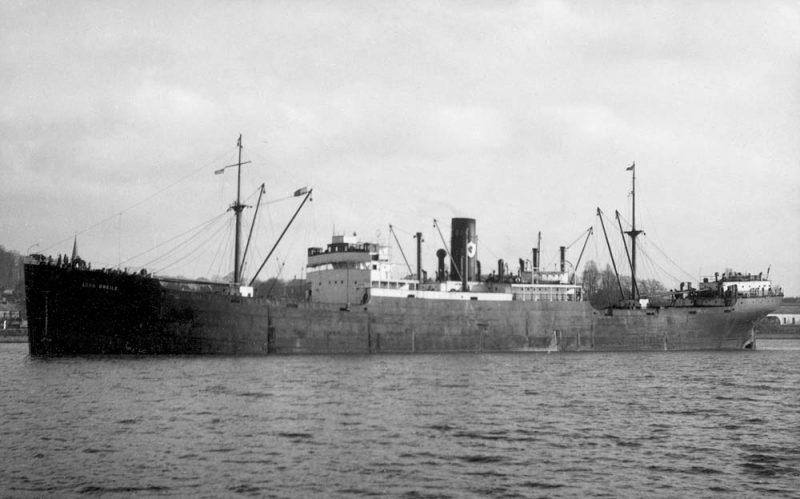
Gustavus Heyn (1803-1875), born in Danzig, arrived in Belfast in 1826 to take up the post of Consul for Prussia. He stayed with Capt. William Pirrie and married his daughter, Letitia Pirrie, in 1830, becoming the auditor and a director of the Belfast Harbour Commissioners for eight years until 1855. He then became a shipowner in Belfast from the early 1850s, owning shares on the 64ths system in a fleet of deep sea sailing ships. He bought and sold sailing ships in rapid succession and operated them carrying passengers and cargo in many trades. These included three masted barques, brigs, brigantines, schooners and snows with names such as Advena, Alpha, British Queen, British Princess, Evangeline, Jessie Amelia, Lady Mary, Lady Sale, Jane Hughes, Jane Erskine, Josepha, Julie Heyn, Rival (lost in the Irish Sea in 1854), Kezia, Union and Volant. His two sons, James and Frederick, then set up the Ulster Steamship Co. Ltd. in Belfast on 25th August 1877, known as the Head Line as most ships had names of Irish headlands e.g. Inishowen Head. Funnel colours were black bearing the ‘Red Hand of Ulster’ on a white shield, and these striking funnel colours were worn by a fleet of 58 steamers and motor vessels and fifty managed ships over the next century. A third son, John Heyn, later became an agent for this company in New Orleans.
Ulster Steamship Co. Ltd.
The Ulster Steamship Co. Ltd. with offices in Ulster Chambers in Waring Street in Belfast had an authorised capital of £100,000, taken up by seven Belfast merchants and shipowners, including James Heyn and Frederick Heyn. A fleet of short sea traders and tramps was operated in the timber trades of the Baltic, and the ‘triangular’ trade of coal out to the Mediterranean, ballast to the Black Sea, and grain from Nicolaieff and Odessa back to northern European ports. Larger tramps loaded coal on the Tyne or at Cardiff for worldwide destinations including Bombay, Madras, Calcutta or Singapore, and returned with Far Eastern cargoes. China clay was loaded at Fowey in Cornwall for the ceramic and paper industries of Canada and the U.S.A., with regular voyages to New Orleans begun in 1896 and also carrying a few passengers. The winter Canadian ports of Halifax (NS) and St. John (NB) were used instead of St. Lawrence ports, and the Canadian Government later paid a winter subsidy for services from these two ports to Belfast and Dublin, Cork or Londonderry.
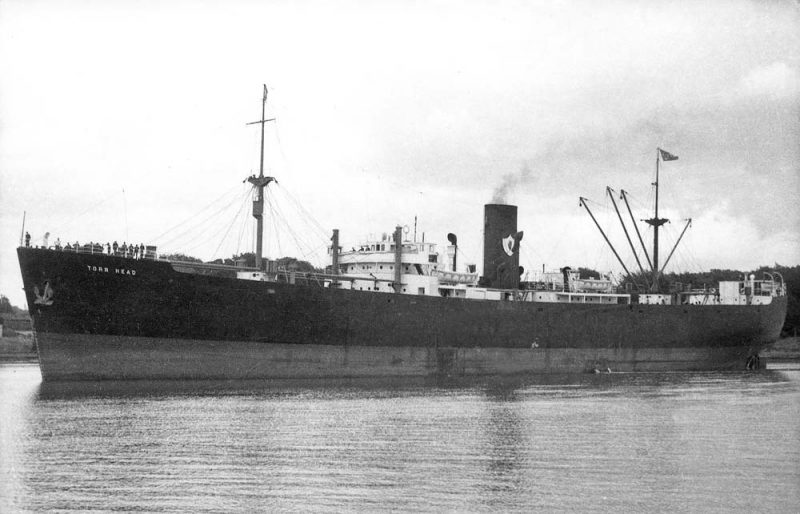
The first of 21 Belfast built vessels, out of a total fleet of 58 ships, and the first with a ‘Head’ suffix to her name, was launched as Fair Head on 24th May 1879 by the Belfast yard of Harland & Wolff Ltd. and completed five weeks later. Heyn also had vessels built at Belfast by Workman, Clark & Co. Ltd. and McIlwaine and McColl Ltd. The size of the worldwide tramping fleet increased rapidly with big five and six hold tramps including Inishowen Head of 4,900 dwt in 1886, Malin Head of 5.500 dwt purchased in 1889, Ramore Head of 6,450 dwt in 1891, Torr Head of 8,700 dwt in 1894, Glenarm Head of 6,000 dwt in 1897, and the twin screw Rathlin Head of 9,875 dwt in 1899.
Torr Head sailed from Cardiff on her maiden voyage with a coal cargo on 12th April 1894 for Bombay and arrived on 7th May via Suez, and sailed again on 26th May for Ijmuiden where she arrived on 1st July. She then made further voyages to Malta and Singapore with coal cargoes from Cardiff later that year, sailing from Singapore to Marseille with a full cargo. On 1st February 1901, she rescued the crew of the German sailing ship Helene in mid North Atlantic. The Master and navigating officers were awarded gold medals, a portrait of the German Emperor, and handsome binoculars in beautiful cases, while the crew received monetary gifts. She berthed at Belfast on 12th October 1904 with a cargo of three thousand hogsheads of Kentucky tobacco loaded at Norfolk (Va). She was then placed on the regular trade from New Orleans and Galveston, with occasional cargoes of nitrate from Chilean ports. She made a voyage in February and March 1913 from Liverpool to Calcutta, returning to London. She was requisitioned for one month as a stores carrier by the Admiralty on the outbreak of World War I.
The smaller White Head of 1,192 grt was launched on 5th May 1880 by Harland & Wolff Ltd. for the Continental and Baltic trades. She loaded in Belfast, Barrow, Glasgow, Bristol and the Tyne with coal for Bremerhaven, Riga and Cronstadt. She sailed from Swansea with coal for Alexandria on 11th November 1881, and after sailing from Cardiff with coal on 17th March 1882 for the Mediterranean she encountered thick fog and ran into and sank the steamer Alert anchored off Lavernock Point with the loss of one crew member. Marine casualties included Horn Head in August 1893 after she had passed Cape Henry while on a voyage from Baltimore to Dublin with general cargo, thirty lives being lost. A fleet of thirteen ships was being traded at the turn of the century with full employment in the trades outlined above, but Black Head stranded on Bornholm in the Baltic on 26th January 1912 while on a voyage from Reval to Belfast. Malin Head stranded in the Pentland Firth on the 21st October 1910 while on a voyage from Dublin and the Tees to Montreal with pig iron, and was subsequently refloated and beached but became a total loss during a prolonged bout of bad weather.
World War I
A fleet of sixteen ships was being traded in August 1914 at the beginning of World War I, with fourteen owned and managed ships lost to the carnage of unrestricted submarine warfare declared by Germany at the start of 1917. All but one of the losses happened during 1917/18, and one of the Head Line ships was able to hit back at the U boats when she served as a ‘Q’ ship with concealed powerful guns ready to be unmasked when a surfaced U-boat approached within firing range. Carrigan Head, completed in 1901, was requisitioned for service at the start of the war as a coaling supply ship for the Naval squadrons, then also served as an expeditionary transport for two months in 1916, and then as the ‘Q4’ ship from June 1916 to August 1917. She completed her service as a commissioned escort vessel in February 1919 and returned to commercial Head Line service.
White Head was requisitioned by the Admiralty on the day war broke out for various roles including naval store carrier, expeditionary force transport vessel, and was on charter for some months to the Government of Montenegro. She supplied coal and stores to the naval fleet at Mudros Bay from May 1916 until her loss to the north of Suda Bay on Crete on 15th October 1917. The full list of ships lost to enemy action was as follows:-
- Orlock Head shelled and sunk on 13th April 1916 by U34 when 65 miles SE of Barcelona while on a voyage from Genoa and Valencia to Glasgow with general cargo.
- Inishowen Head torpedoed and sunk on 14th February 1917 when 1.25 miles off Skokholm Island in West Wales while on a voyage from Dublin to St. John (NB) in ballast, one life lost.
- Bray Head torpedoed and sunk on 14th March 1917 when 375 miles WNW of the Fastnet while on a voyage from St. John’s (NFL) to Belfast with general cargo, 21 lives lost.
- Howth Head torpedoed and sunk on 19th April 1917 when 158 miles NW of the Fastnet while on a voyage from New Orleans and Norfolk (Va) to Dublin, two lives lost.
- Torr Head torpedoed and sunk on 20th April 1917 when 160 miles WNW of the Fastnet by U60 while on a voyage from St. John (NB) to Dublin with general cargo.
- Dunmore Head torpedoed and sunk on 27th April 1917 when 135 miles NW of Tory Island by U62 while on a voyage from Manchester to Genoa with coal.
- Bengore Head torpedoed and sunk on 20th June 1917 when 150 miles NW of the Fastnet by U60 while on a voyage from Sydney (NS) to London with general cargo.
- Black Head torpedoed and sunk on 21st June 1917 when 52 miles ESE of the Skerries in Shetland while on a voyage from Christiania (Oslo) and Drammen to Lerwick and Leith with wood pulp.
- White Head torpedoed and sunk on 15th October 1917 when 40 miles NNE of Suda Bay in Crete by UC74, 23 lives lost.
- Garron Head torpedoed and sunk on 16th November 1917 when 40 miles off Bayonne by U103 while on a voyage from Bilbao to Barrow and Maryport with iron ore, 28 lives lost.
- Glenarm Head torpedoed and sunk on 5th January 1918 when five miles SSW of Brighton while on a voyage from Southampton to Boulogne with ammunition, two lives lost.
- Teelin Head torpedoed and sunk on 27th January 1918 when 12 miles SSW of the Owers Light Ship, 13 lives lost.
- Huntsmoor (twin funnelled managed ship) torpedoed and sunk on 20th February 1918 by UB40 when 23 miles from the Owers Light Ship.
- Hungerford (managed) torpedoed and sunk on 16th April 1918 by UC75 nine miles SSE of the Owers Light Ship while on a voyage from ports in the U.S.A. to France.
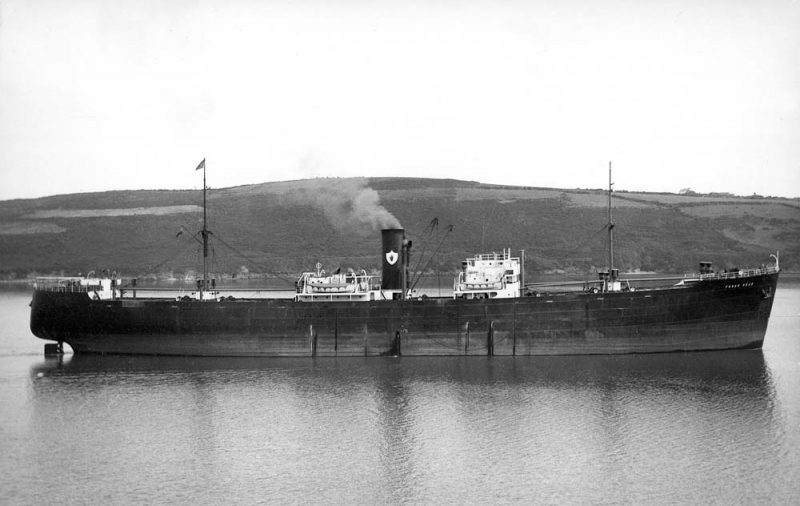
Inter-War Years
Lord Line Ltd. of Belfast had been absorbed in 1916/17 by G. Heyn & Sons Ltd. along with their five general cargo ships of Lord Antrim, Lord Downshire, Lord Glentoran, Lord Londonderry and Lord O’Neill, all engaged on services from Belfast, Dublin, Cardiff and Rotterdam to Baltimore and Galveston, and also to Montreal and Quebec during the summer season. Agreement was reached in 1919 between the Ulster Steamship Co. Ltd. and Palgrave, Murphy & Company of Dublin and Hudig & Veder N.V. of Rotterdam to form a working partnership and to pool vessels. There were limited inter-fleet sales of vessels between the three partners, as well as changes of management e.g. Wicklow Head 1,453/79 was purchased from Palgrave, Murphy & Co. Ltd. in May 1919 as City of Munich, and three vessels from Palgrave, Murphy & Co. Ltd. in City of Dublin 1,108/82, City of Cork 939/81 and City of Antwerp 951/96 were managed by Heyn & Sons Ltd. for twenty months from August 1932. The Hudig & Veder steamer Calaeno 3,544/16 was managed by Heyn & Sons Ltd. from 1933 as Lurigethan after purchase by the Heyn associate company of the Mountain Steamship Co. Ltd., established in 1933, with Lurigethan the name of a flat topped mountain near Cushendall in coastal North Antrim.
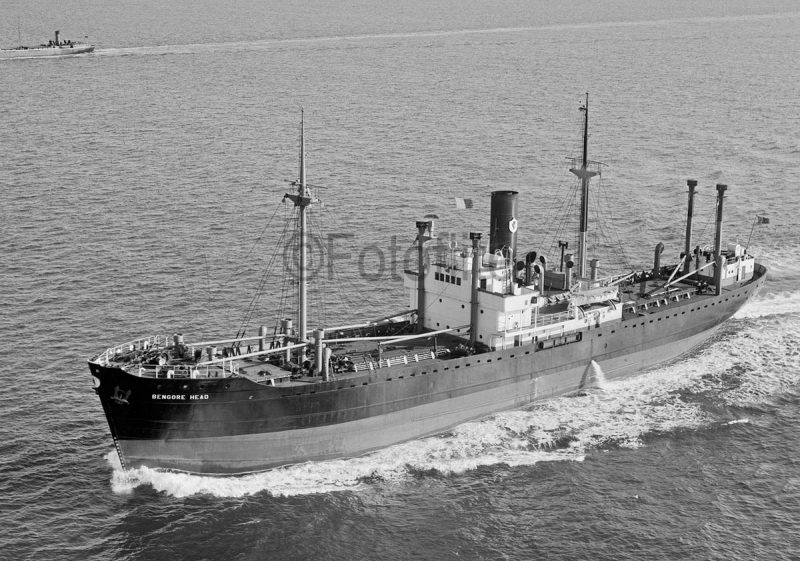
A large fleet of eighteen steamers was being operated in 1920 on services from Belfast and Dublin to Montreal, Quebec, St. John (NB), Baltimore, New Orleans, Galveston, Rotterdam, Hamburg, Petrograd, Reval and Riga. There were six Heyn family directors living at addresses in Strandtown House in Belfast and in Craigavad in County Down. The loading berths were at York Dock in Belfast and the Alexandra Basin in Dublin, and the following agents were used worldwide:-
- Dublin – Palgrave, Murphy & Co.
- New Orleans – Ross & Heyn
- Galveston – J. Merrow & Company
- Hamburg – Turnbull & Jacobs
- Montreal – McLean, Kennedy Ltd.
- Quebec – McLean, Kennedy Ltd.
- St. John (NB) – McLean, Kennedy Ltd.
- Reval – P. Bornholdt & Co.
- Riga – Head Line Agency(C.J. Small)
- Rotterdam – Hudig & Veder
- Toronto – Fred C. Thompson, Royal Bank Building
The Ulster Steamship Co. Ltd., managed by Heyn & Sons Ltd., fleet in 1932 had been reduced to fifteen ships due to the drastic reduction in cargoes available during the Depression, with long waits in port until cargoes became available. There were five ships in the range of 8,200 to 8,400 dwt that were employed on the Montreal and Three Rivers service in Dunaff Head of 1918, Fanad Head of 1917, Kenbane Head of 1919, Melmore Head of 1918 and powered by three turbines, and Torr Head of 1923. The latter vessel was sold to Chilean owners in 1933 for the low price of £15,226 and renamed Angol. Lord Antrim and Lord Londonderry were employed on bringing timber cargoes in from Archangel, and the other eight ships were usually employed on the Continental and Baltic services, these being Bengore Head of 1922, Carrigan Head of 1901, Dunmore Head of 1898, Fair Head of 1879, Glen Head of 1883, Orlock Head of 1921, Teelin Head of 1897 and Wicklow Head of 1879.

Glen Head stranded on Bornholm in the Baltic on 9th December 1934 while on a voyage from Riga to Cork and Londonderry with timber and later broke up. Wicklow Head and Teelin Head were sold in 1934 to a Palgrave, Murphy & Co. Ltd. company and renamed City of Ghent and City of Bremen respectively. Two further old steamers were purchased during 1935/37 for the Continental services and renamed Fair Head 1,718/06 and Glen Head 2,011/09. A five hold general cargo vessel of 8,490 dwt with accommodation for a dozen passengers was completed by the Harland & Wolff Ltd. yard at Belfast in April 1937 as Torr Head (3) for the St. Lawrence and Canadian service.
World War II
A fleet of ten ships was being traded by Head Line on 3rd September 1939, with five large general cargo ships on Transatlantic service, and five small vessels on Continental and Baltic service. Torr Head of 1937 was the only survivor of this fleet by the end of the war, and two managed ships were also sunk. Several French ships were managed including the big deep sea tanker Saintonge of 9,400 grt, the general cargo ship Lieut. Robert Mory, and the pilot vessels Albert Faroult and Bruine. Heyn & Sons Ltd. managed between six to eight ships during each of the six long war years, including American built ships dating from World War I, and new standard ‘Empire’ ships built during World War II.
Fanad Head was in Montreal on the day of the outbreak of war, preparing to sail with general cargo and grain for U.K. ports, and eleven days later she was steaming towards the coast of Ireland 280 miles WNW of Malin Head when at 1323 hours she was sighted by U30, which had already sunk the liner Athenia and tramp Blairlogie. U30 surfaced and gave chase and Fanad Head radioed for assistance, with a warning shot fired across her bows from the 88 mm gun of the U boat. Capt. George Pinkerton stopped his ship to save life and 33 crew and 8 passengers were put into the lifeboats, which U30 took in tow and put a prize crew onboard Fanad Head to gather provisions and scuttle her.

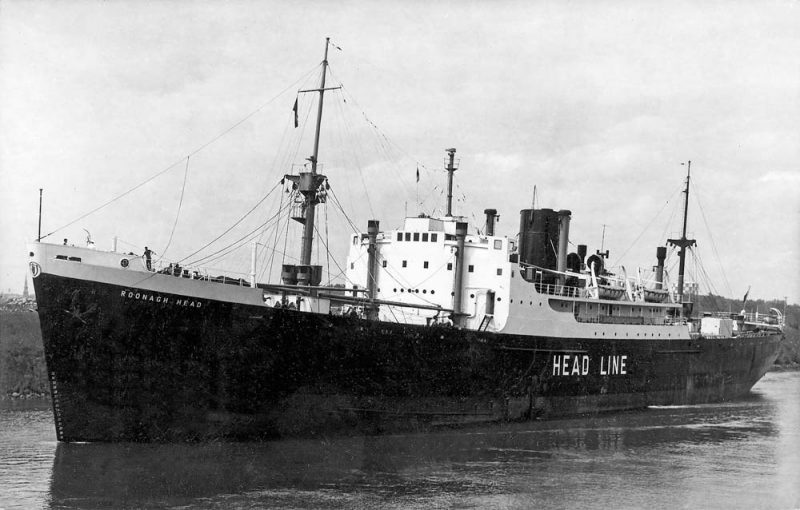
The distress call reached the aircraft carrier Ark Royal on anti-submarine patrol two hundred miles NE of the Belfast ship, and she launched three ‘Skua’ aircraft and detached the ‘Tribal’ class destroyers Bedouin, Punjabi and Tartar to her assistance. Ark Royal launched six more ‘Swordfish’ aircraft and also detached the ‘F’ class destroyers Fame and Forester as reinforcements. Unfortunately, two of the three ‘Skua’ aircraft were lost during the low level strafing and bombing attempts on the surfaced U30 with shrapnel from the bombs hitting their tails and their pilots left swimming to the nearby Fanad Head. U30 continued to try to come alongside Fanad Head to take off the German prize crew, but damaged her bow on the third attempt, and then succeeded in taking off the five man prize crew. Shortly after, the first ‘Swordfish’ aircraft arrived, forcing U30 to submerge, and at 1820 hours she launched a torpedo from her stern tube at a range of 500 metres and sank Fanad Head.
U30 was repeatedly attacked with bombs by the six ‘Swordfish’ aircraft and depth charges from two destroyers. The destroyer Tartar rescued the passengers and crew of Fanad Head and took them to Mallaig in Scotland. U30 continued to be attacked during the evening until 2200 hours, sustaining considerable damage, but she was able to make Reykjavik for temporary repairs and then Wilhelms-haven for major repairs, with the two captured Royal Navy pilots sent off to a prisoner of war camp in Brunswick for the remainder of the war. The full list of Head Line owned and managed ships lost, apart from Fanad Head, during the long war is as follows:-
- Dunmore Head requisitioned by the Admiralty on the outbreak of war as an ammunition hulk and not returned to commercial service, being broken up at Milford Haven in March 1951.
- Orlock Head bombed and sunk after passing Duncansby Head and Dunnet Head in the Pentland Firth on 21st July 1940 while on a voyage from London to Liverpool in convoy OA190, four lives lost.
- Trito (managed) sunk by aircraft bombs south of Portland Bill on 20th September 1940 while on a voyage from Port Talbot to Dartmouth, Southampton and Shoreham, with only two survivors from her crew.
- Kenbane Head shelled and sunk by the pocket battleship Admiral Scheer on 5th November 1940 off Greenland while on a voyage from Montreal and Sydney (NS) to Belfast.
- Dunaff Head torpedoed and sunk by German submarine UA on 8th March 1941 to the south of Iceland while on a voyage from the Clyde to St. John’s (NFL) in convoy OB293, five lives lost.
- Empire Frost (managed) bombed and damaged on 12th March 1941 by aircraft in the Bristol Channel, and sunk by aircraft the following day while under tow.
- Fair Head damaged by aircraft bombs at Belfast on 5th May 1941, two lives lost, and later broken up at Ballyholme Bay at Bangor (County Down).
- Bengore Head torpedoed and sunk by U110 when 400 miles east of Cape Farewell, Greenland on 9th May 1941 while on a voyage from Belfast and Glasgow to Montreal in ballast.
- Glen Head bombed and sunk by aircraft on 6th June 1941 to SW of Cape St. Vincent while on a voyage from Glasgow to Lisbon and Gibraltar.
- Melmore Head torpedoed and sunk by U225 on 28th December 1942 when north of the Azores while on a voyage from Newport and Belfast to St. John (NB).
Head Line had only two owned ships left afloat at the end of the war in Torr Head of 1937 and the newer Fanad Head of 1940, completed by the Belfast yard of Harland & Wolff Ltd. for Transatlantic service.
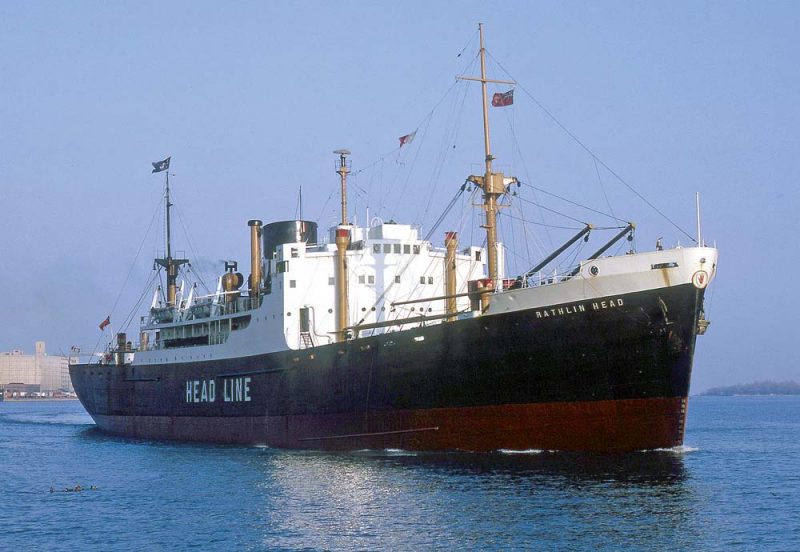
Post-War Years
A ship replacement programme was put in hand at the end of the war, with two sisters of 8,830 dwt dating from completion in 1930 by the Beardmore yard on the Clyde, Dalhanna and Daldorch, purchased and renamed Lord O’Neill and Lord Glentoran. A standard 10,000 dwt war built general cargo ship and a smaller ‘Scandinavian’ type that had been managed during the war, Empire Glade and Empire Wolfe, both built in 1941, were purchased and renamed Inishowen Head (2) and Wicklow Head (2). This pair joined the war survivors Torr Head of 1937 and Fanad Head of 1940, and a programme of building three general cargo ships of around 9,250 dwt and powered by twin turbines was put in hand, the first of which appeared in August 1948 as Ramore Head. This shelterdecker had dimensions of length 455.0 feet, moulded beam of 59.5 feet and draft of 27.5 feet, with a cruiser stern, and was followed in 1952/53 by her near sisters Roonagh Head and Rathlin Head. They carried a dozen First Class passengers and had a service speed of 15 knots to give a passage time from Glasgow to the ports of the St. Lawrence of two weeks.
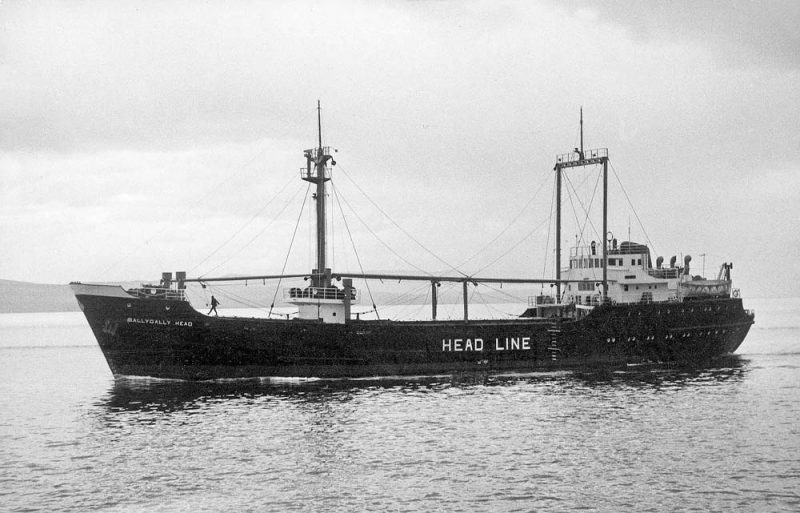
Unfortunately, Wicklow Head (2) was lost after running aground in fog at Joli Point, Port Mouton Island in Nova Scotia on 2nd May 1947 while on a voyage from Ardrossan to St. John (NB) in ballast. Salvage was proposed, but five weeks later she was further damaged in heavy weather and abandoned.
A fleet of fourteen ships was traded in 1951, with many charters obtained in the Transatlantic trades to Canadian Pacific for Canadian sailings, which continued after the purchase of Donaldson Line of Glasgow in 1967 and became Head-Donaldson Lines. The number of westbound charters to CP Lines by company vessels in post-war years was as follows:-
- Fanad Head – 6 – 1947-1960
- Torr Head (3&4) – 20 – 1947-1966
- Inishowen Head (2&3) – 15 – 1948-1967
- Ramore Head – 44 – 1950-1967
- Roonagh Head – 37 – 1953-1967
- Rathlin Head – 37 – 1954-1966
- Carrigan Head – 24 – 1959-1966
- Fair Head – 15 – 1963-1967
A total of 198 westbound charters to CP Lines was made with 179 sailing from Liverpool, and two eastbound charters to CP Lines were made by the turbine powered Carrigan Head of 10,020 dwt, completed in 1958, in 1967 from St. John’s in Newfoundland to Liverpool. In the last week of October 1960, seven company ships were engaged in the Canadian and American eastern seaboard trades as follows:-
- Carrigan Head under Capt. Haddock sailed from Liverpool on 27th October for Seven Islands and Montreal, where she loaded for Belfast, Dublin and Liverpool.
- Fair Head under Capt. Greene sailed from Montreal on 24th October to head into the Great Lakes ports of Toronto, Detroit, Milwaukee and Chicago.
- Inishowen Head under Capt. Clarke sailed from Wilmington (NC) on 24th October for Belfast, Dublin and Liverpool.
- Ramore Head under Capt. Davey arrived on 27th October at Belfast from Montreal and Quebec, and later sailed for Dublin and Liverpool.
- Rathlin Head under Capt. Stark sailed from Dalhousie (Ontario) on 25th October to complete loading at Montreal and Port Alfred on the Saguenay River for Belfast, Dublin and Liverpool.
- Roonagh Head sailed from Glasgow on 25th October with a full general cargo for Detroit and Chicago.
- Torr Head sailed from Montreal on 25th October for Belfast, Dublin and Liverpool.
Two Sulzer diesel powered general cargo ships were completed by the Sunderland yard of Austin & Pickersgill Ltd. in 1961 and 1965 as Torr Head (4) and Inishowen Head (3) of around 9,700 to 10,000 dwt on a summer draft of 26.3 feet. Torr Head was given a five cylinder Sulzer diesel of 7,500 bhp to give a service speed of fifteen knots, whereas Inishowen Head was given a more powerful Sulzer diesel of 9,600 bhp to give a service speed of seventeen knots and cut two days off her Transatlantic passage times.
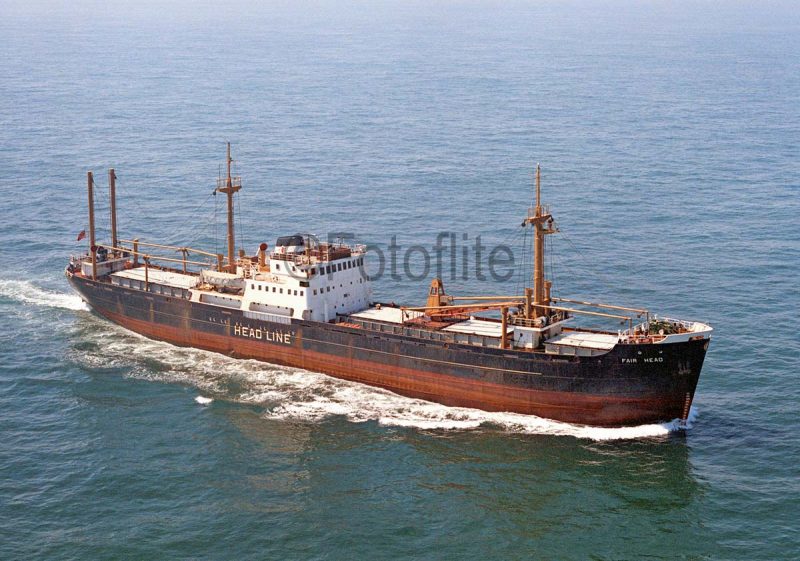
The advent of containerisation on the North Atlantic saw Inishowen Head (3) converted into a cellular container ship by Harland & Wolff Ltd. in 1969, with her forward cargo gear ripped off to give the ability to carry 368 TEU of containers including sixteen reefer containers. She had ‘HEAD DONALDSON LINE’ painted in big white letters on both sides of her hull for a weekly service from Greenock to Quebec, Montreal, Toronto and Hamilton in association with Canadian Pacific Steamships Ltd. and later Manchester Liners. By 1973, she was too small for this expanding trade, and she was chartered out to Cast Line as Cast Beaver, making twelve day voyages from Manchester to Haifa. She regained her name of Inishowen Head in 1977 but was sold two years later to Canadian owners for charter to Saguenay Terminals Ltd. as Sunhermine, eventually being cut up for scrap in Busan in Korea in late 1986.
Continental, Baltic And Other Trades
A reduced service to the Continent and the Baltic was operated in 1947 by a purchased ‘Hansa A’ type, renamed as Bengore Head, and Fair Head also purchased in 1947 as Arklow from the Clyde Shipping Co. Ltd. of Glasgow. This reduction was partly due to the establishment of Irish Shipping Ltd. on 21st March 1941 with competing services to the Continent to ensure that the Republic of Ireland could import and export essential goods during World War II. Three American built standard ‘N3’ types with bridge ‘midships were purchased in 1949 and renamed Kinsale Head, Dunmore Head and Malin Head, two of these had been managed by the company during the war. On 20th April 1950, Malin Head suffered an engine room explosion at 1637 hours while on a voyage from Belfast to Barry. The Chief Engineer William A. Miller died in hospital from his injuries, while the Second and Third Engineers and a donkeyman and a fireman received injuries from which they recovered. The explosion had occurred shortly after the ship left Bangor Bay at 1610 hours, and she anchored to allow small craft to take the injured to hospital, after treatment with morphine from the ship’s medicine chest. Two replacement engineers arrived onboard and after an inspection of the engine, the vessel was able to continue her voyage to Barry, where she arrived on 22nd April.
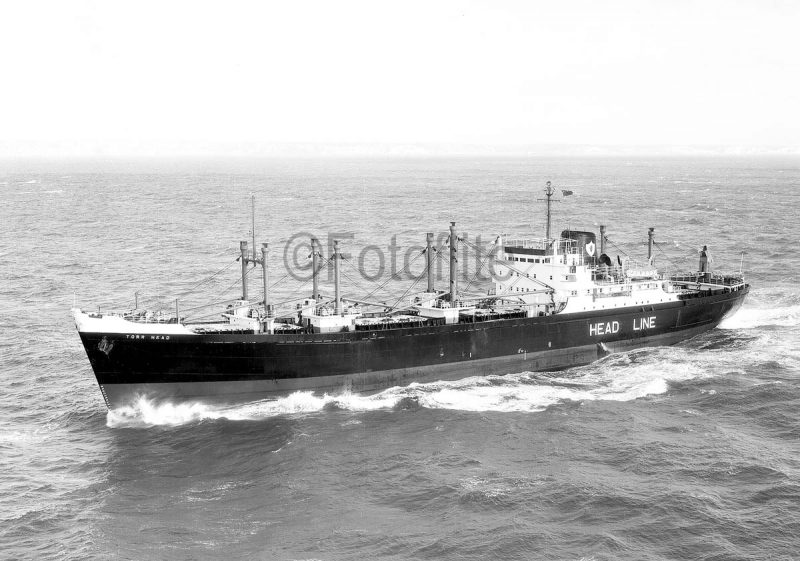
An engines aft new coaster of 1,226 dwt was delivered by the Dutch yard of Arnhemsche Scheepsbouw Maats in March 1954 as Ballygally Head, and an order for an engines ‘midships coaster 25 feet longer was then given to the same yard for completion as Fair Head (4) of 2,605 dwt in March 1957. Fair Head (4) was later lengthened by 47 feet in 1964 increasing her carrying capacity to 3,200 dwt, and served to the Great Lakes, with both vessels powered by Werkspoor diesels. Fair Head (4) had cargo gear on two masts and a pair of posts at her stern, with an electric crane after she was lengthened. She was the last coastal vessel left in the fleet in 1974 when she was sold for further service to Maldive owners for service in the Indian Ocean.
A new trade in Irish horses, cattle and sheep being shipped to France, Holland, Belgium, Poland, Italy and North Africa was begun in 1946 with the purchase of two coastal vessels from the Clyde Shipping Co. Ltd., Glasgow in Copeland of 1923 and Goodwin of 1917, renamed as North Down and North Tipperary respectively. Another coastal shipping opportunity presented itself in 1954 when the Dutch coaster owner Gruno Groningen B.V. wished to dispose of its Dublin subsidiary of Coastal Shipping Ltd. This latter company was managed by none other than Palgrave, Murphy & Co. Ltd., with which Heyn & Sons Ltd. had long co-operated since the early inter-war years. A Heyn investment was made, and Fair Head (3) was sold to Palgrave, Murphy & Co. Ltd. in 1954 and renamed City of Hamburg, and joined City of Cork, the former North Tipperary sold off in 1947.
Head Line Building
A stylish three storey building had been purchased in 1917 at 10-14 Victoria Street in Belfast and became the main Heyn & Sons Ltd. office for nearly seventy years. The building was designed in the ‘Venetian Renaissance Palazzo’ style by architect Thomas Jackson & Son, with a start in construction in June 1863 and completion during 1864 by the contractor John Lowry & Son at a cost of £14,000. The client was the Scottish Amicable Life Assurance Company, who specified a central projecting section, rounded arch windows, and keystones on all floors and some decoration above the door. The chamfered buff/pink sandstone blocks were erected on a limestone plinth, with Peterhead granite also used alongside the Dungannon sandstone.
The foyer of the building received extensive bomb damage by the IRA in 1976, with a large amount of replacement and alterations to the ground floor by the time the building had been repaired in 1979. Heyn & Sons Ltd. sold their last ship Inishowen Head of 1965 in 1979 but retained this building for a number of years afterwards. The building was refurbished during 1999 with additional space built in at roof level and a basement car park added. The stonework condition is now good with occasional pitting and iron staining only, and some flaking and scaling of the limestone dressing, but the building is being fully used today by new Belfast businesses to create new wealth and opportunities in the now settled conditions of this great Ulster city.
Heyn Group Ltd.
The last member of the Heyn family of Belfast shipowners, Carl Heyn, had died on 1st December 1957 without issue to carry on the name. Heyn Group Ltd. was formed In October 1986 by David Clarke and Michael Maclaren, and later in 1997 they moved into purpose built premises at Corry Place on Belfast Harbour Estate close to the container quays to act as shipping agents and freight forwarders for global shipping companies such as Hong Kong based OOCL, Hamburg based Hamburg Sud and DAL, MacAndrews of London, and Finnlines of Finland. Heyn Shipping is very proactive in the type of cargo moved, including products and raw materials of the forestry, food, construction, manufacturing, and textile industries, by sea, air and road freight.

Heyn Engineering Ltd. was later set up in the same premises to handle crane, hoist, materials handling and lifting solutions to industrial, manufacturing and logistics companies in Northern Ireland, Eire and the U.K., giving continuity of almost two hundred years to the Heyn name in Belfast from the early 1820s. Heyn Engineering has broadened its services from marine engineering to include a comprehensive range of lifting equipment and accessories, machinery installation, load testing and materials handling products. The future for the Heyn name in Belfast looks good with these services and further details of the other Heyn Group Ltd. services, Heyn Environmental and Heyn Forklifts, can be obtained from their excellent website at www.heyn.co.uk.
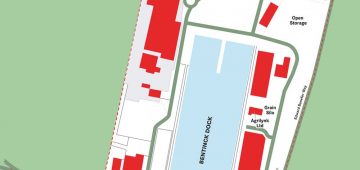



Comments
Sorry, comments are closed for this item